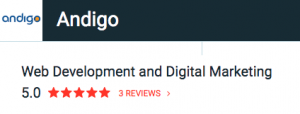A bit more than a year ago, we found out we had competition. Of course, we’ve always had competition from other digital marketers and web developers. Now, we had competition for our name.
The Motorola Employees Credit Union decided to change its name to Andigo Credit Union. (We weren’t offended when the general consensus of MECU’s members was, “What the @#$% is an Andigo?” We love our name, and there’s a good story behind it, but we think it lacks a certain something as a name for a credit union, too.)
Now searches for Andigo turn up results for the credit union more often than for us. Not ideal, of course, but how to fight back against a much larger entity, especially when that entity isn’t even really a competitor?
Since we really do walk the walk when it comes to the digital marketing talk that we talk, we got to work shoring up our own presence online. We’ve long be active in creating content for our own site, for a select few other sites, like Target Marketing and Biznology, and for allowing other re-publish and promote our work. (More on that below.) We’re also active on social media channels like LinkedIn and Twitter.
To that mix, we’ve begun adding elements of social proof and reputation marketing AKA reputation management. Let’s define both.
Social Proof
Social proof can take many forms the most common of which are testimonial quotes from clients and client reviews. The testimonial quotes are most often found on our own websites and in our own social media feeds, particularly recommendations on LinkedIn. These are worth cultivating as they offer prospects a chance to get a sense of what it’s like to work with you from clients who have already worked with you. Being in the clients’ own words adds much more power to these statements.
Another element of social proof is how aggregators might pick up your content marketing. We’re proud that our work is frequently picked up by various services that round up content they feel is most valuable to the audience they’ve created. In our case, those audiences are digital marketers who might be looking for consultants and agencies.) The aggregator’s stamp of approval is a powerful motivator since your target audience is undoubtedly besieged by more content than they can possibly consume.
One of our recent wins in this area is being named to Feedspot’s Top 100 B2B Marketing Blogs. We’re proud to be recognized, of course, but we’re also excited about how the listing is likely to broaden our audience and introduce us to prospects and colleagues we would not have otherwise had the opportunity to meet.

Reputation Management / Reputation Marketing
Reputation management is frequently misunderstood as a sort of reactionary marketing activity, one often engaged in to counteract the effects of a single strongly negative review. The basic premise: if you cultivate many, many positive reviews, one strongly negative review will register more as “noise” than as “signal.” As this idea has spread, marketers are wisely being more proactive and building their positive reviews before a negative review comes along to upset the apple cart.
We recently create a profile at Clutch.co, which in our view combines great elements of reputation marketing and social proof. Clutch is a ratings / review platform that focused on B2B service firms. It’s free to use and their process for collecting in-depth reviews is detailed enough to paint a pretty comprehensive review of you and your firm. You can see our Clutch profile here, and sign up for your own, as well.

Two final notes: First, nobody’s perfect, and it’s nearly impossible to be in business for very long before you either make an error or simply aren’t able to meet a client’s needs. So bad reviews will happen.
What’s even more important than having lots of good reviews and testimonials as a counterweight is how you address the negative review. Prospects will respond to your tone and honesty more than anything else since they understand that they don’t really know what may have happened. So channel your grandparents when you engage with unhappy reviewers: be as polite as members of that generation would have been and you’ll rarely go wrong.
Second, all of this and $2.75 will get you on the subway in New York. Meaning, reputation management and social proof are important, but they are not stand-alone solutions. You must use them in a more comprehensive digital marketing strategy.